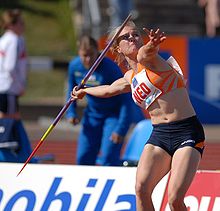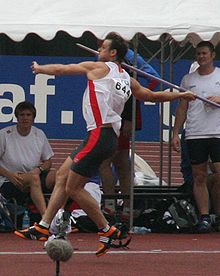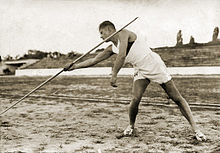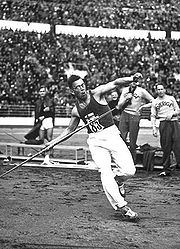- Javelin throw
-
The javelin throw is a track and field athletics throwing event where the object to be thrown is the javelin, a spear approximately 2.5 metres in length. Javelin is an event of both the men's decathlon and the women's heptathlon. The javelin thrower gains momentum by running within a predetermined area.
Contents
Rules and Competitions
The size, shape, minimum weight,and center of gravity of the javelin implement itself are all defined by IAAF rules. In international competition, men throw a javelin between 2.6 and 2.7 metres in length and (at least) 800 grams in weight, and women throw a javelin between 2.2 and 2.3 metres in length and (at least) 600 grams in weight. The javelin is equipped with a grip, approximately 150 mm wide, made of cord and located at the javelin's center of gravity (0.9 to 1.06 metres or 0.8 to 0.92 metres from the tip of the javelin for men's and women's implements, respectively).
Unlike the other throwing events (shotput, discus, and hammer), the technique used to throw the javelin is dictated by IAAF rules and "non-orthodox" techniques are not permitted. The javelin must be held at its grip and thrown overhand, over the athlete's shoulder or upper arm. Further, the athlete is prohibited from turning completely around such that his back faces the direction of throw. In practice, this prevents athletes from attempting to spin and hurl the javelin sidearm in the style of a discus throw. Instead of being confined to a circle, javelin throwers are provided with a runway 4 metres wide and at least 30 metres in length, ending in a curved arc from which their throw will be measured; athletes typically use this distance to gain momentum in a "run-up" to their throw. Like the other throwing events, the competitor may not leave the throwing area (the runway) until after the implement lands. The need to come to a stop behind the throwing arc limits both how close the athlete can come to the line before the release as well as the maximum speed achieved at the time of release.
The javelin is thrown towards a "sector" covering an angle of 29 degrees extending outwards from the arc at the end of the runway. A throw is legal only if the tip of the javelin lands within this sector, and the tip strikes the ground before any other part of the javelin. The distance of the throw is measured from the throwing arc to the point where the tip of the javelin landed, rounded down to the nearest centimetre.
Competition rules are similar to other throwing events: a round consists of one attempt by each competitor in turn, and competitions typically consist of three to six rounds. The competitor with the longest single legal throw (over all rounds) is the winner; in the case of a tie the competitors' second-longest throws are also considered. Competitions involving large numbers of athletes sometimes use a "cut": all competitors compete in the first three rounds, but only athletes who are currently among the top eight or have achieved some minimum distances are permitted to attempt to improve on their distance in additional rounds (typically three).
Javelin redesigns
On April 1, 1986, the men's javelin (800 grams (1.76 lb)) was redesigned by the governing body (the IAAF Technical Committee). They decided to change the rules for javelin construction because of the increasingly frequent flat landings and the resulting discussions and protests when these attempts were declared valid or invalid by competition judges. The world record had also crept up to a potentially dangerous level, 104.80 metres by Uwe Hohn. The javelin was redesigned so that the centre of gravity was moved 4 cm forward, further away from the centre of pressure (the point at which the aerodynamic forces of lift and drag act), so that the javelin had an increased downward pitching moment. This brings the nose down earlier, reducing the flight distance by around 10% but also causing the javelin to stick in the ground more consistently. In 1999, the women's javelin (600 grams (1.32 lb)) was similarly redesigned.
Modifications that manufacturers made to recover some of the lost distance, by increasing tail drag (using holes, rough paint or dimples), were outlawed at the end of 1991 and marks made using implements with such modifications removed from the record books. Seppo Räty had achieved a world record of 96.96 metres in 1991 with such a design, but this record was nullified.
History and the javelin at the Olympics
During the era between the Mycenaean times and the Roman Empire, the javelin was a commonly used offensive weapon. Being lighter than the spear, the javelin would be thrown rather than thrust and thus allowed long distance attacks against one’s enemy. Athletes, however, used javelins that were much lighter than military ones because the idea of the event was to demonstrate distance rather than penetration. The one major difference between the javelin of the ancient games and the javelin of more modern times is a leather thong, called an ankyle that was wound around the middle of the shaft. Athletes would hold the javelin by the thong and when the javelin released this thong unwound giving the javelin a spiraled flight.[1]
The javelin throw has a particularly strong tradition in the Nordic nations of Europe. Of the 69 Olympic medals that have been awarded in the men's javelin, 32 have gone to competitors from Norway, Sweden, or Finland.[2] Finland is the only nation to have ever swept the medals at a currently recognized official Olympics, and has done so twice, in 1920 and 1932. (However, Sweden swept the first four places at the 1906 Intercalated Games. Finland's 1920 sweep also featured an additional fourth place finish. Sweeping the first four places is no longer possible, as only three entrants per country are allowed.) In 1912, Finland also swept the medals in the only appearance in the Olympics of two-handed javelin, an event in which the implement was separately thrown with both the right hand and the left hand and the marks were added together. Quite popular in Finland and Sweden at the time, this event soon faded into obscurity, together with similar variations of the shot and the discus.
Technique and training
Unlike other throwing events, javelin allows the competitor to build speed over a considerable distance. In addition to the core and upper body strength necessary to deliver the implement, javelin throwers benefit from the agility and athleticism typically associated with running and jumping events. Thus, the athletes share more physical characteristics with sprinters than with other, heavier throwing athletes.
Traditional free-weight training is often used by javelin throwers. Metal-rod exercises and resistance band exercises can be used to train a similar action to the javelin throw to increase power and intensity. Without proper strength and flexibility, throwers can become extremely injury prone, especially in the shoulder and elbow. Core stability can help in the transference of physical power and force from the ground through the body to the javelin. Stretching and sprint training are used to enhance the speed of the athlete at the point of release, and subsequently, the speed of the javelin. At release, a javelin can reach speeds approaching 113 km/h (70 mph).
Best year performance
Men's seasons best
Year Distance Athlete Place 1971 90.68  Jānis Lūsis (URS)
Jānis Lūsis (URS)Helsinki 1972 93.80  Jānis Lūsis (URS)
Jānis Lūsis (URS)Stockholm 1973 94.08  Klaus Wolfermann (FRG)
Klaus Wolfermann (FRG)Leverkusen 1974 89.58  Hannu Siitonen (FIN)
Hannu Siitonen (FIN)Rome 1975 91.38  Miklós Németh (HUN)
Miklós Németh (HUN)Budapest 1976 94.58  Miklós Németh (HUN)
Miklós Németh (HUN)Montreal 1977 94.10  Miklós Németh (HUN)
Miklós Németh (HUN)Stockholm 1978 94.22  Michael Wessing (FRG)
Michael Wessing (FRG)Oslo 1979 93.84  Pentti Sinersaari (FIN)
Pentti Sinersaari (FIN)Auckland 1980 96.72  Ferenc Paragi (HUN)
Ferenc Paragi (HUN)Tata 1981 92.48  Detlef Michel (GDR)
Detlef Michel (GDR)Berlin 1982 95.80  Bob Roggy (USA)
Bob Roggy (USA)Stuttgart 1983 99.72  Tom Petranoff (USA)
Tom Petranoff (USA)Westwood 1984 104.80  Uwe Hohn (GDR)
Uwe Hohn (GDR)Berlin 1985 96.96  Uwe Hohn (GDR)
Uwe Hohn (GDR)Canberra A new model was introduced in 1986, and all records started fresh.
Women's seasons best
Year Distance Athlete Place 1980 70.08  Tatyana Biryulina (URS)
Tatyana Biryulina (URS)Podolsk 1981 71.88  Antoaneta Todorova (BUL)
Antoaneta Todorova (BUL)Zagreb 1982 74.20  Sofia Sakorafa (GRE)
Sofia Sakorafa (GRE)Hania 1983 74.76  Tiina Lillak (FIN)
Tiina Lillak (FIN)Tampere 1984 74.72  Petra Felke (GDR)
Petra Felke (GDR)Celje 1985 75.40  Petra Felke (GDR)
Petra Felke (GDR)Schwerin 1986 77.44  Fatima Whitbread (GBR)
Fatima Whitbread (GBR)Stuttgart 1987 78.90  Petra Felke (GDR)
Petra Felke (GDR)Leipzig 1988 80.00  Petra Felke (GDR)
Petra Felke (GDR)Potsdam 1989 76.88  Petra Felke (GDR)
Petra Felke (GDR)Macerata 1990 73.08  Petra Felke (GER)
Petra Felke (GER)Manaus 1991 71.44  Trine Hattestad (NOR)
Trine Hattestad (NOR)Fana 1992 70.36  Natalya Shikolenko (BLR)
Natalya Shikolenko (BLR)Moscow 1993 72.12  Trine Hattestad (NOR)
Trine Hattestad (NOR)Oslo 1994 71.40  Natalya Shikolenko (BLR)
Natalya Shikolenko (BLR)Seville 1995 71.18  Natalya Shikolenko (BLR)
Natalya Shikolenko (BLR)Zürich 1996 69.42  Steffi Nerius (GER)
Steffi Nerius (GER)Monaco 1997 69.66  Trine Hattestad (NOR)
Trine Hattestad (NOR)Helsinki 1998 70.10  Tanja Damaske (GER)
Tanja Damaske (GER)Berlin A new model was introduced in 1999 and all records started fresh.
Year Distance Athlete Place 1999 68.19  Trine Hattestad (NOR)
Trine Hattestad (NOR)Fana 2000 69.48  Trine Hattestad (NOR)
Trine Hattestad (NOR)Oslo 2001 71.54  Osleidys Menéndez (CUB)
Osleidys Menéndez (CUB)Rethymno 2002 67.47  Miréla Manjani (GRE)
Miréla Manjani (GRE)Munich 2003 66.52  Miréla Manjani (GRE)
Miréla Manjani (GRE)Paris 2004 71.53 (OR)  Osleidys Menéndez (CUB)
Osleidys Menéndez (CUB)Athens 2005 71.70  Osleidys Menéndez (CUB)
Osleidys Menéndez (CUB)Helsinki 2006 66.91  Christina Obergföll (GER)
Christina Obergföll (GER)Athens 2007 70.20  Christina Obergföll (GER)
Christina Obergföll (GER)Munich 2008 72.28 (WR)  Barbora Špotáková (CZE)
Barbora Špotáková (CZE)Stuttgart 2009 68.92  Mariya Abakumova (RUS)
Mariya Abakumova (RUS)Berlin 2010 68.89  Maria Abakumova (RUS)
Maria Abakumova (RUS)Doha Top ten
Men's best throwers of all time (current 1986 model)
- (Updated April 2010)
Rank Mark Athlete Place Date 1. 98.48  Jan Železný (CZE)
Jan Železný (CZE)Jena 1996-05-25 2. 93.09  Aki Parviainen (FIN)
Aki Parviainen (FIN)Kuortane 1999-06-26 3. 92.61  Sergey Makarov (RUS)
Sergey Makarov (RUS)Sheffield 2002-06-30 4. 92.60  Raymond Hecht (GER)
Raymond Hecht (GER)Oslo 1995-07-21 5. 91.69  Konstadinós Gatsioúdis (GRE)
Konstadinós Gatsioúdis (GRE)Kuortane 2000-06-24 6. 91.59  Andreas Thorkildsen (NOR)
Andreas Thorkildsen (NOR)Oslo 2006-06-02 7. 91.53  Tero Pitkämäki (FIN)
Tero Pitkämäki (FIN)Kuortane 2005-06-26 8. 91.46  Steve Backley (GBR)
Steve Backley (GBR)Auckland 1992-01-25 9. 91.29  Breaux Greer (USA)
Breaux Greer (USA)Indianapolis 2007-06-21 10. 90.73  Vadims Vasiļevskis (LAT)
Vadims Vasiļevskis (LAT)Tallinn 2007-07-22 Women's best throwers of all time (current 1999 model)
- (Updated September 2011)
Rank Mark Athlete Place Date Ref 1. 72.28  Barbora Špotáková (CZE)
Barbora Špotáková (CZE)Stuttgart 2008-09-13 2. 71.99  Mariya Abakumova (RUS)
Mariya Abakumova (RUS)Daegu 2011-09-02 [3] 3. 71.70  Osleidys Menéndez (CUB)
Osleidys Menéndez (CUB)Helsinki 2005-08-14 4. 70.20  Christina Obergföll (GER)
Christina Obergföll (GER)Munich 2007-06-23 5. 69.48  Trine Hattestad (NOR)
Trine Hattestad (NOR)Oslo 2000-07-28 6. 68.38  Sunette Viljoen (RSA)
Sunette Viljoen (RSA)Daegu 2011-09-02 [4] 7. 68.34  Steffi Nerius (GER)
Steffi Nerius (GER)Elstal 2008-08-31 8. 67.67  Sonia Bisset (CUB)
Sonia Bisset (CUB)Salamanca 2005-07-06 9. 67.51  Miréla Manjani (GRE)
Miréla Manjani (GRE)Sydney 2000-09-30 10. 67.20  Tatyana Shikolenko (RUS)
Tatyana Shikolenko (RUS)Monaco 2000-08-18 Notable javelin throwers
See also
- Javelin throwers have been selected as a main motif in numerous collectors' coins. One of the recent samples is the €5 Finnish 10th IAAF World Championships in Athletics commemorative coin, minted in 2005 to commemorate the 2005 World Championships in Athletics. On the obverse of the coin, a javelin thrower is depicted. On the reverse, legs of hurdle runners with the Helsinki Olympic Stadium tower in the background can be seen.
References
- ^ The Ancient Olympic Games by Judith Swaddling
- ^ http://www.databaseolympics.com/sport/sportevent.htm?sp=ATH&enum=330
- ^ "Javelin Throw Results". IAAF. 2 September 2011. http://daegu2011.iaaf.org/documents/pdf/4147/AT-JT-W-f--A--.RS1.pdf. Retrieved 2 September 2011.
- ^ "Javelin Throw Results". IAAF. 2 September 2011. http://daegu2011.iaaf.org/documents/pdf/4147/AT-JT-W-f--A--.RS1.pdf. Retrieved 2 September 2011.
External links
The following sites contain more information and statistics for Javelin throwing as well as for other track and field sports:
- (IAAF Statement) – statement of reasons to modify the javelin design
- World Record progression in athletics men
- World Record progression in athletics women
- Masters World Rankings
- IAAF competition rules
- Javelin History
Events in the sport of athletics Track Sprints Hurdles 50 m · 55 m · 60 m · 100 m · 110 m · 400 mMiddle distance Long distance Relays 4 × 100 m · 4 × 200 m · 4 × 400 m · 4 × 800 m · 4 × 1500 m · Distance medley relay · Sprint medley relay · Swedish relayField Throws Jumps Combined Road Running Walking 10 km · 20 km · 50 kmCategories:- Events in athletics (track and field)
- Olympic sports
- Ancient Olympic sports
- Olympic medalists in athletics (track and field)
Wikimedia Foundation. 2010.





